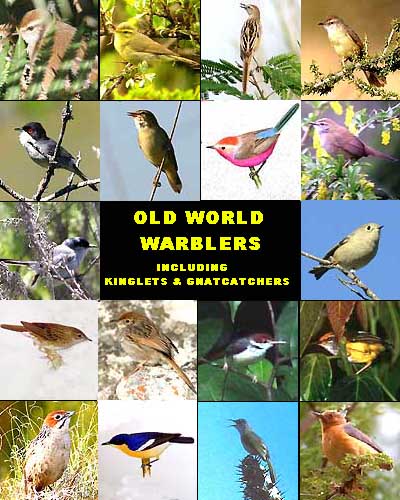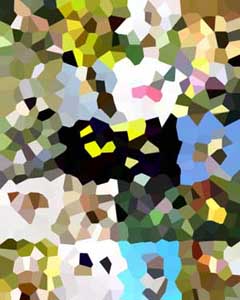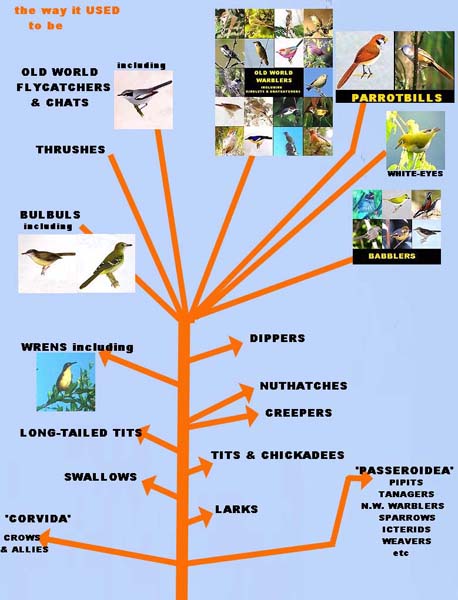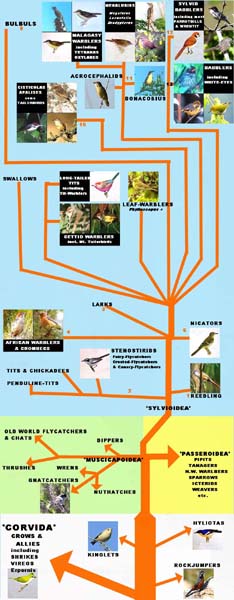OLD WORLD WARBLERS
| Not long ago, the Old World Warblers family [Sylviidae] was thought to be composed of ~400 species, representing a wide range of diversity in small passerines, from skulking undergrowth specialists to tree-top denizens. As recently as the 7th ed. A.O.U. Checklist (1998), Gnatcatchers were considered to be a subfamily. As recently as 2003, the Handbook of the Birds of the World, Vol. 8, included Kinglets among the Sylviidae [AOU split the kinglets, HBW split the gnatcatchers]. A panoply of recently-included groups are shown at right: (L to R, row by row): Cettia bush-warblers, Phylloscopus leaf-warblers, Megalurus grassbirds, prinias & apalises, Sylvia warblers, Acrocephalus warblers, Leptopoecile tit-warblers, Bradypterus bush-warblers, gnatcatchers, kinglets, Locustella grasshopper-warblers, cisticolas, Orthotomus tailorbirds (two photos), Cape Grassbird, hyliotas, Thamnornis & other Malagasy warblers, and crombecs. |
 |
 But
new genetic research has taken this picture, and shattered it into a million
pieces (just as I have done with the gallery of photos by this PhotoShop
effect!). Some initial concepts were laid by Sibley & Ahlquist (1990)
and Sibley & Monroe (1990) but in many respects they were off-target.
Direct DNA evidence has been the key, and recent work by Cibois et al.
(1999, 2001), Cibois (2003), Barker et al. (2004), and Beresford et al.
(2005) showed that the Old World Warblers were going to have to be broken
up and put back together.
But
new genetic research has taken this picture, and shattered it into a million
pieces (just as I have done with the gallery of photos by this PhotoShop
effect!). Some initial concepts were laid by Sibley & Ahlquist (1990)
and Sibley & Monroe (1990) but in many respects they were off-target.
Direct DNA evidence has been the key, and recent work by Cibois et al.
(1999, 2001), Cibois (2003), Barker et al. (2004), and Beresford et al.
(2005) showed that the Old World Warblers were going to have to be broken
up and put back together.
In 2006, Jønsson & Fjeldså reviewed 99 genetic studies to construct a tentative 'supertree' of relationships in the passerine birds. These are the 'perching birds' that account for about half of the birds in the world. Alström et al. (2006) focused on the former Sylviidae [Old World Warblers] and Timaliidae [Babblers], and began the process of proposing new Family names for some of the lineages following the Sylvoid break-up. An overview look at what things looked like recently is shown below (left) and what things may look like in the future (following the Jønsson & Fjeldså tree) is shown below right.
 |
 |
| All readers should understand this important point raised by Dr. F.K.
Barker upon reviewing a first draft of these pages: "That is the distinction
between systematics and taxonomy. The former is science, and the latter
an art. That is, systematics is the science of discovering and describing
diversity. So, we delineate species and (now) discover the evolutionary
relationships among those species using character data (often DNA sequences).
Taxonomy is the practice or "art" of naming the diversity that is discovered
by scientific practice. That's not to say that it is unimportant — we need
names for things— but there's never been a really satisfactory way to do
this in a fashion that is anything but arbitrary."
Birders tend to be more interested in the "taxonomy" part — which taxa are considered species and which are just subspecies (if using the Biological Species Concept, as I do). At a higher level, what is a Family as contrasted to "just" a Subfamily or Tribe? This is because for many of us birding is recreation, leisure, or compulsion, but not science (or not only science). Many of us structure decisions on where to go birding because of taxonomic concepts. I have certainly given priority in my world travel to searching for representatives of new Families, as a means of enjoying the search for great diversity in birds. But we should not forget that what is a Family is an arbitrary, man-made distinction — subject to philosophical variances on such question as how great of a diversity is required for Family level, or how much emphasis (if any) should be placed on historical concepts about Families — and these can and will differ from person to person, even if everyone accepts the same scientific insights provided by systematic research. There are many examples of this variance in the following pages. |
|
|
|
OF THE OLD TREE Click Here |
OF THE NEW TREE Click Here |
Alström P., P.G.P. Ericson, U. Olsson, and P. Sundberg. 2006. Phylogeny and classification of the avian superfamily Sylvoidea. Molecular Phylogenetics & Evolution 38: 381-397.Barker, F.K., A. Cibois, P. Schikler, J. Feinstein, and J. Cracraft. 2004. Phylogeny and diversification of the largest avian radiation. Proc. Nat. Acad. Sci. 101: 11040-11045.
Beresford, P., F.K. Barker, P.G. Ryan, and T.M. Crowe. 2005. African endemics span the tree of songbirds (Passeri): molecular systematics of several evolutionary 'enigmas'. Proc. R. Soc. B 272: 849-858.
Cibois, A., E. Pasquet, and T.S. Schulenberg. 1999. Molecular systematics of the Malagasy babblers (Timaliidae) and Warblers (Sylviidae), based on cytochrome b and 16S rRNA sequences. Molecular Phylogenetics & Evolution 3: 581-595.
Cibois, A., B. Slikas, T.S. Schulenberg, and E. Pasquet. 2001. An endemic radiation of Malagasy songbirds is revealed by mitochondrial DNA sequence data. Evolution 55: 1198-1206.
Cibois, A. 2003. Mitochondrial DNA phylogeny of babblers (Timaliidae). Auk 120: 35-54.
Dickinson, E.C., ed. 2003. The Howard & Moore Complete Checklist of the Birds of the World. 3d ed. Princeton Univ. Press, Princeton, N.J.
Jønsson, K.A., and J. Fjeldså. 2006. A phylogenetic supertree of oscine passerine birds. Zoologica Scripta 35: 149-186.
Sibley, C.G., and J.E. Ahlquist. 1990. Phylogeny and Classification of Birds: A Study in Molecular Evolution. Yale Univ. Press, New Haven, CT.
Sibley, C. G., and B.L. Monroe, Jr. 1990. Distribution and Taxonomy of Birds of the World. Yale Univ. Press, New Haven, CT.